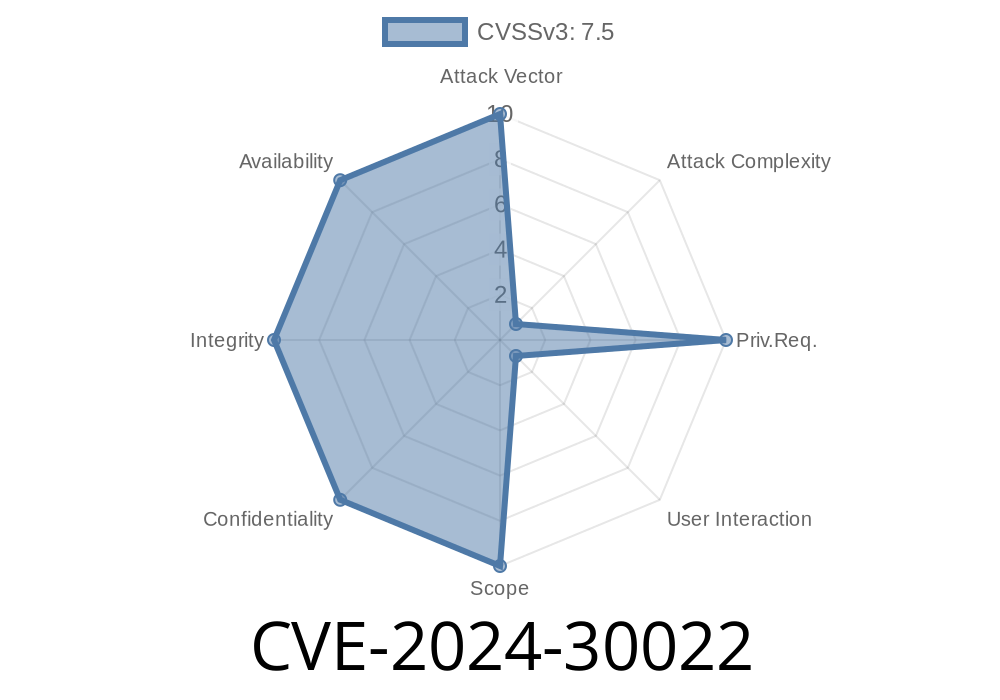In May 2024, Microsoft published security updates for several critical vulnerabilities. One of the most significant is CVE-2024-30022, a Remote Code Execution (RCE) vulnerability in Windows Routing and Remote Access Service (RRAS). This post will break down how CVE-2024-30022 works, why it matters, code snippets that show vulnerable contexts, exploit potential, and resources for remediation. If you’re managing a Windows Server environment with RRAS, this is a *must-read*.
What is RRAS?
The Windows Routing and Remote Access Service (RRAS) lets organizations route network traffic, act as a VPN server, and enable dial-up networking for remote users. RRAS is a powerful tool, but because it interacts directly with network traffic, vulnerabilities can be _extremely_ damaging.
What is CVE-2024-30022?
CVE-2024-30022 is a vulnerability allowing an attacker to remotely execute code on servers where RRAS is enabled and exposed. An unauthenticated user could send specially crafted packets to the RRAS service and potentially take complete control of the target system—installing programs, viewing, changing, or deleting data, or creating new accounts with full user rights.
Severity: Critical (CVSS 9.8)
Affected Products:
- Windows Server 2012/2016/2019/2022 (with RRAS enabled)
- Some versions of Windows 10/11 with RRAS features
Attack Vector: Network
Authentication Required: No
How Does the Vulnerability Work?
Microsoft hasn’t published all technical details to prevent widespread exploitation. However, analysis by the security community points to improper input validation in the handling of RRAS network packets.
A remote attacker can trigger the vulnerability by sending a carefully crafted packet to a system with RRAS enabled. If the packet exploits the vulnerable code path, it can cause a buffer overflow or similar memory corruption issue.
Example Vulnerable Logic
Here’s a simplified code snippet (not the real RRAS code, but similar in spirit), showing how lack of proper checks may allow exploit:
// Example: Unchecked buffer copy (just for illustration)
void HandleRRASPacket(char *inputPacket, int length) {
char buffer[512];
// No length check - buffer overflow possible!
memcpy(buffer, inputPacket, length);
// ...Process packet
}
If an attacker sends length > 512 data, the buffer overflows, enabling arbitrary code execution. Real-world RRAS code is more complex, but the principle is similar.
Exploitation Steps (hypothetical)
1. Scan for Windows servers with TCP ports associated with RRAS (e.g., port 1723 for PPTP, custom ports for VPN).
Send the malicious packet—no authentication needed.
4. Achieve remote code execution if the exploit succeeds. Typical payloads add a user or drop a reverse shell.
Unusual outgoing network connections from RRAS hosts.
Proof-of-Concept
No public PoC exploit is available as of June 2024, but security testing tools and frameworks like Metasploit are expected to release modules once more details emerge.
1. Apply Microsoft Updates
The official patch was released as part of May 2024 "Patch Tuesday":
Reference: Microsoft Advisory for CVE-2024-30022
> Patch ASAP. Do not wait if you are using RRAS anywhere in your environment.
2. Disable RRAS If Not Needed
If you don't require remote access or VPN routing, disable RRAS altogether.
3. Restrict Network Access
Use firewall rules to limit who can talk to the RRAS service, blocking untrusted or public access.
4. Monitor Logs and Network Traffic
Look for signs of scanning or exploitation, especially against known RRAS ports.
Resources & References
- Microsoft Security Response Center: CVE-2024-30022
- NIST National Vulnerability Database
- Microsoft: Routing and Remote Access Service
Conclusion
CVE-2024-30022 is among the most severe RRAS vulnerabilities discovered recently. Since no authentication is needed, exposed services are at extreme risk. Patching and basic security hygiene (firewalls, service minimization) are your best defenses.
> Bottom line: Update RRAS systems _immediately_. Don’t expose RRAS to the Internet unless absolutely necessary, and keep your security tools (EDR, NIDS) alert for exploitation attempts.
Stay safe and keep your network patched!
*Original exclusive write-up for community awareness. For more direct details, always consult the official references above.*
Timeline
Published on: 05/14/2024 17:16:55 UTC
Last modified on: 06/19/2024 20:58:33 UTC
